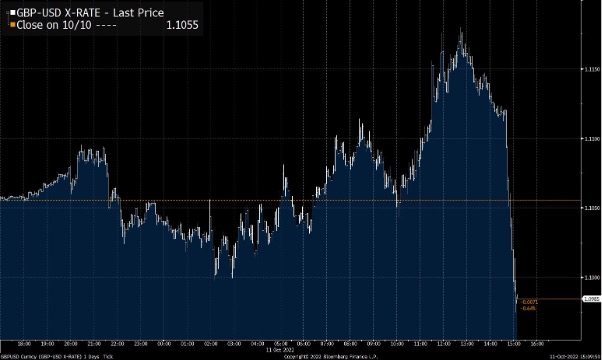
The Governor of the Bank of England, speaking at an IMF conference yesterday evening:

Bank of England, as reported before breakfast this morning:

In between time, the pound had done this:

Modern central banking is mostly about the communications of modern central banking. Take former European Central Bank president Mario Draghi’s declaration that he would do “whatever it takes” to save the euro, in 2012. Did Draghi actually have to do “whatever it takes”? No, just declaring clearly and credibly that he would was enough to end the speculation around the terms of the euro’s disintegration and immediately improve financial condition in the eurozone and beyond.
What Bailey and the Bank of England have just done is the exact opposite.
Confusion
So why the confusion? Why the mixed messaging? The Bank’s fundamental problem, beneath whatever it wants to tell the world, is that its two major objectives now contradict. The Bank of England, like any central bank, has a primary task of ensuring financial stability. This is why central banks exist at all, in their modern form: central banks emerged as a “lender of last resort” for a currency’s banking system, meaning it was known by all other banks, financial institutions, and their customers, that the central bank was ready to step in and preserve the system’s stability if needed – by issuing emergency loans to failing institutions, for example.
Their second function, inflation targeting, emerged only very much later – really in the last few decades or so. Although much better-known today, inflation targeting by central banks is only possible because of their fundamental role in trying to preserve financial stability. By acting as the fundamental support for the whole monetary system, central banks develop great powers over the system. The interest rate central banks pay on the bank accounts the commercial banks hold with them grows to exercise a control over interest rates in the system more generally. When the Bank of England or some other central bank is reported to be adjusting “the” interest rate, this “Bank rate” is the rate it is adjusting. The idea is that by the central bank changing the interest rate paid out on its own reserves, every other bank and financial institution will adjust its own interest rates. (The Bank of England has a clear explainer here.)
Under normal circumstances, these two functions work together. The Bank of England’s Monetary Policy Committee (MPC) meets monthly to set the Bank’s main interest rate, aiming to keep inflation at the government’s target level of 2%. The Financial Policy Committee, meanwhile, keeps an eye out for future financial crises and potential instability. After the 2008 crash, the MPC has also overseen the massive programme of government bond-buying called “Quantitative Easing” (QE), taking decisions on the value of government bonds the Bank should buy with freshly-issued Bank money. Novel in early 2009 when it was introduced, for good or ill QE is now an accepted part of most central banks’ policy toolkits. Again, this has all been accepted as normal, innocent central bank behaviour – even when QE was expanded by some £400bn to cover the costs of covid in 2020. At the start of September, the MPC announced it would be reversing QE with “Quantitative Tightening” (QT) – selling government bonds back to the financial markets – as part of its effort to control inflation, alongside increasing the Bank rate.
Normal
Alas, the times are not normal, and haven’t been for a while. Kwasi Kwarteng’s mini-Budget on September 23rd, containing £45bn of additional borrowing (on top of the Energy Price Guarantee) and including an unexpected new tax cut for the wealthiest, sparked an almighty panic amongst those in financial markets. The pound fell rapidly in value against other currencies and the price demanded by traders for lending to the British government – the “gilt rate” – shot up. This sudden change in the gilt rate in turn seems to have destabilised British pension funds, who had, over the previous decade or more, developed sophisticated ways to try and match up the payments they make to pensioners with the earnings they receive from their assets. These techniques, collectively known as “Liability Driven Investment” were sophisticated but, it turned out, fragile if market conditions changed rapidly. By Monday 26th, there was a risk that some pension funds faced insolvency and therefore of much wider market disorder.
The Bank of England, as the situation worsened, moved on Wednesday 29th to operate its primary function: preserving financial stability, promising up to £5bn-worth of additional bond-buying a day for the next 13 working days, and ending Quantitative Tightening.
But notice that this is a screeching reverse of the earlier decision to start QT to combat inflation. The Bank’s aim of preserving financial stability runs directly counter, right now, to its aim of keeping inflation low. The same tools and instruments are being used to try and do two, contradictory things. This contradiction by itself would be a decent reason for the Bank to try and impose a time limit on the extra support it has offered, and was (presumably) the reason for setting that limit. But without the pension funds magically managing to reorganise themselves at very short notice – and the picture here is unclear – the time limit just delayed the inevitable, currently set to arrive on Friday morning.
This contradiction is the reason for the confusion at the top of the Bank. But the confusion should alarm all of us. The Bank of England has been the most important economic institution in the country for the last decade. Time and again its interventions have enabled an otherwise weak economy to steer through a series of crises, from Brexit to covid, with relatively little damage. If the Bank is now itself starting to look as dysfunctional as every other major institution, we are collectively in a very bad place. And it is absolutely not a good look for the governor of a central bank to say one big, important thing and then have himself immediately contradicted by his own bank a few short hours later.
Chicken
What to do? There might be ways for the Bank to try and manage this mess more effectively. Steven Major, HSBC’s head of global research has suggested they should make clear the financial stability intervention is only buying long-term bonds (which it is), whilst the monetary policy intervention (“Quantitative Tightening”) is only selling short term bonds (which it is). These are two different parts of the market and two different financial products, so – in theory – two different interventions could be applied. Major goes on to suggest that the Bank rate could still be used to signal the Bank’s intentions about inflation, with Bank rate rises (expected to be steep over the next few months) continuing.
Perhaps more fundamentally, as former Permanent Secretary to the Treasury Nick Macpherson has said, it isn’t actually the Bank’s job to bail out pension funds. That falls to the government – the Bank was only bounced into intervening as it became apparent, barely two weeks ago, that a general failure of pension funds had bigger market implications. That would mean the Treasury pulling together a rescue package for the funds, which, one way or another, means adding still further to the government’s rapidly rising pile of debt and more pressure on interest rates. One, possibly generous, reading of Bailey’s behaviour is that he has thrown down the gauntlet not so much to pension funds as to the government: that either the Treasury will have this mess resolved by Friday, or the Bank will not be responsible for the consequences. (You may think it’s a bad sign that a central bank is playing chicken with its own government, and you’d be absolutely right.)
So a quick, relatively low-cost resolution to the current mess would be for the government to U-turn on whatever remains of the Budget, although plausibly this would end Kwasi Kwarteng’s political career; the slower, higher-cost resolution would involve a government backstop for failed pension funds, although this might allow Chancellor Kwarteng to remain in Number Eleven. It’s a dilemma: who amongst us can truly say which of these options is best? Most likely, of course, is some fudge, whereby the Bank declares and end to the current round of exceptional support, but then cunningly reintroduces something quite similar looking for Monday morning whilst the government continues to chisel away at its own mini-Budget.
Either way, the resolution would only be temporary. The cost of government borrowing has been forced upwards, to heights unheard of even a few years ago, and is unlikely to come back down much in the future. The pound continues its long-term decline. The economy is shrinking as we slide into a probable recession. If we get right down to the fundamentals, Britain is a weak, unproductive, low investment, low wage, high debt economy with a massive dependence on imports for essentials like natural gas and food. It has run off fumes for much of the last decade, leaning more and more heavily on the historic reputation of its core institutions – like the Bank of England – to maintain a semblance of progress. But there are limits to how much the Bank can do with monetary policy, and the Truss government has cack-handedly exposed those limits in the last few weeks. Things are only likely to get worse, and potentially much worse, from this point onwards.
